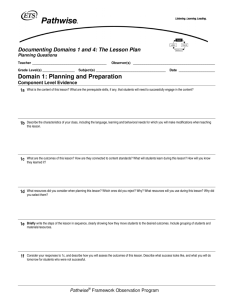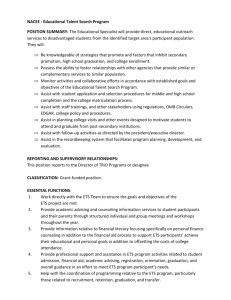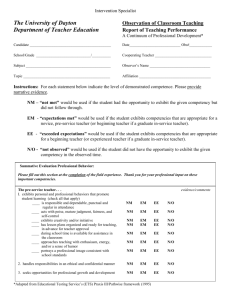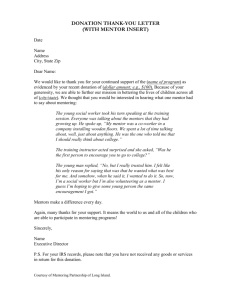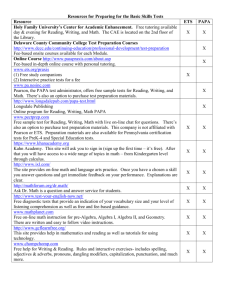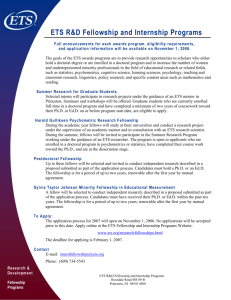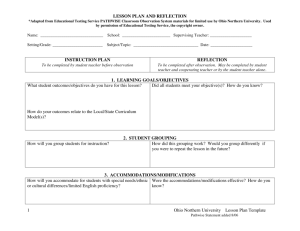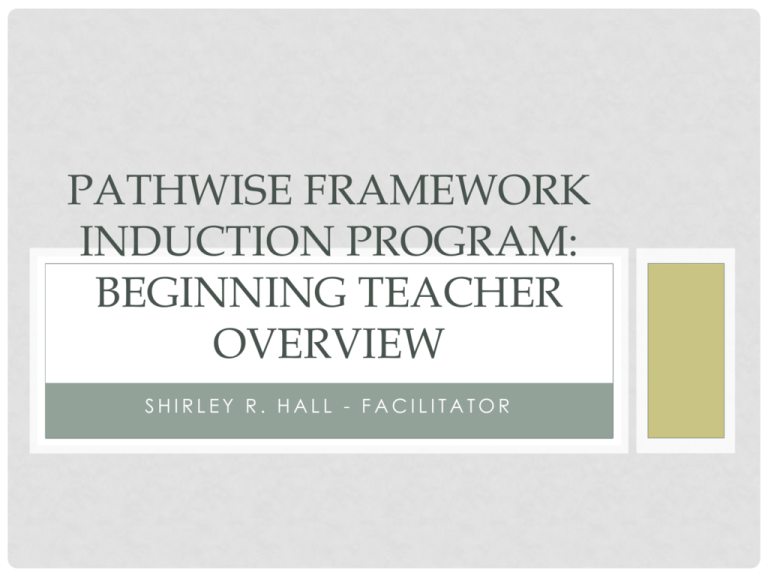
PATHWISE FRAMEWORK
INDUCTION PROGRAM:
BEGINNING TEACHER
OVERVIEW
SHIRLEY R. HALL - FACILITATOR
LEARNING INTENTIONS
Participants will ...
• explore the nature of a quality induction program.
• understand how A Framework for Teaching is
embedded in the induction program so that it aligns
with its use in teacher evaluation.
• understand the developmental structure and
curriculum of the Pathwise Induction Program.
Mentors are those people in our
lives who through their deeds and
work, help us to move towards
fulfilling our potential.
Gordon F. Shea, Mentoring—A Guide to
Basics.
NEW TEACHER ATTRITION
The steep learning curve (for beginning
teachers) is hard not only on students, but also
on the teachers themselves: 15 percent leave
the profession and another 14 percent change
schools after their first year, often as the result of
feeling overwhelmed, ineffective, and
unsupported (Ingersoll & Smith, 2003; Smith &
Ingersoll, 2004).
TOP 3 CHALLENGES
• Take a moment to think
of the top 3 challenges
that you face(d) as a
beginning teacher
• Struggling with Classroom
Management
• Burdened by Curricular
Freedom (including
lesson plans, materials,
etc.)
• Sinking in Unsupportive
Environments
Educational Leadership (May 2012)
Research Says / New Teachers
Face Three Common Challenges
SO, WHAT WOULD SUPPORT LOOK LIKE
TO YOU?
PHASES OF FIRST YEAR
TEACHING
Anticipation
Anticipation
Survival
Reflection
Rejuvenation
Disillusionment
AUG
MAY
JUN
SEPT
JUL
OCT
NOV
DEC
JAN
FEB
MAR
APR
Moir, 1999
Wang and Odell’s (2002) meta-analysis of
mentoring research indicates that most
mentoring programs and practices are
conceived of and executed in humanistic
and/or technical terms, rather than from a
perspective of directly supporting professional
learning. From a humanistic orientation, the role
of mentoring is to provide temporary emotional
support to increase retention by helping new
teachers deal with the “reality shock” and
emotional stress of teaching. Mentors in this
orientation have strong interpersonal skills such as
being good listeners, encouraging, and openminded. (Wang & Odell, 2002)
Technical orientations suggest that the role of mentor
is to be a “local guide” who helps new teachers
adapt to their new contexts. In a technical
orientation, mentors provide advice, offer
suggestions or solutions to problems, explain school
policies and procedures, and help new teachers
complete administrative task. These functions are
intended to facilitate the transition from being a
university student to being the teacher of record and
a member of the school community. Certainly, some
degree of context based assistance is valuable. Yet a
technical orientation predicated on socialization has
limitations.
New Urban Teachers Experience Induction
Coaching: “Moving Vision Toward Reality ”Wendy
Gardiner ; National-Louis University
As a more comprehensive alternative, FeimanNemser (1998) developed and refers to the
term “educative mentoring” (Feiman-Nemser,
2001b; Norman & Feiman-Nemser, 2005) to
advocate for a situated, collaborative
approach intended to improve new teachers’
professional practice.
In an educative framework, mentors go
beyond providing emotional support, tips, and
advice to help new teachers improve their
practice by engaging in collaborative analysis
into classroom events, see the classroom in
increasingly complex ways, and develop
dispositions of reflective inquiry.
INDUCTION INTO THE TEACHING
PROFESSION:
THE SEVEN EVENTS
Event 1
Teaching Environment
Profile
Event 2
Inquiry 1
Establishing A Culture
for Learning
Event 5
Event 4
Profile of Practice
2/Individual Growth
Plan
Inquiry 2
Event 6
Inquiry 3
Analyzing Student
Work
Event 3
Profile of Practice
1/Individual Growth
Plan
Developing
Instructional
Experiences
Event 7
Assessment and
Summary of
Professional Growth
and Colloquium
www.ets.org/efolio/forms.html
FIVE ESSENTIAL COMPONENTS OF
QUALITY
INDUCTION PROGRAMS
• One: Research-Based Definition of Teaching Practice:
A Framework for Teaching, 2nd Edition
• Two: Developmental Structure and Curriculum,
Including Observation and Action Research
Pathwise Framework Induction Program
• Three: Formative Assessment
Levels of Performance
• Four: Trained Mentors
FIP Training for Instructional Mentors
• Five: Reflection on Practice
Plan-Teach-Reflect-Apply Cycle
.
One: Research-Based Definition of Teaching Practice:
A Framework for Teaching, 2nd Edition
Domain 1: Planning and Preparation
Domain 2: The Classroom Environment
a. Demonstrating Knowledge of Content
and Pedagogy
b. Demonstrating Knowledge of Students
c. Setting Instructional Outcomes
d. Demonstrating Knowledge of Resources
e. Designing Coherent Instruction
f. Designing Student Assessments
a. Creating an Environment of Respect
and Rapport
b. Establishing a Culture for Learning
c. Managing Classroom Procedures
d. Managing Student Behavior
e. Organizing Physical Space
Domain 4: Professional Responsibilities
Domain 3: Instruction
a.
b.
c.
d.
a. Communicating with Students
b. Using Questioning and Discussion
Techniques
c. Engaging Students in Learning
d. Using Assessment in Instruction
e. Demonstrating Flexibility and
Responsiveness
Reflecting on Teaching
Maintaining Accurate Records
Communicating with Families
Participating in a Professional
Community
e. Growing and Developing Professionally
f. Showing Professionalism
Confidential. Copyright © 2007 by Educational
Testing Service. All rights reserved. ETS, the
ETS logo and PATHWISE are registered
trademarks of Educational Testing Service
(ETS).
Two: Developmental Structure and Curriculum,
Including Observation and Action Research
Pathwise Framework Induction Program
THREE: FORMATIVE ASSESSMENT
LEVELS OF PERFORMANCE
FOUR: TRAINED MENTORS
FIP TRAINING FOR INSTRUCTIONAL MENTORS
Events Two, Three, Five and Seven*
Evidence is a factual reporting of events.
It may include teacher and student
actions and behaviors. It may also include
artifacts prepared by the teacher,
students or others. It is not clouded with
personal opinion or biases. It is selected
using professional judgment by the
observer and/or the teacher.
* Artifacts are key in Event 7
EVIDENCE OR OPINION?
1.
The teacher did a good job of managing
materials.
2.
There is a somewhat negative relationship
between the teacher and students.
3.
The teacher stood by the door, distributing
books to students as they entered.
4.
The teacher could have spent less time on the
guided practice portion of the lesson.
Confidential. Copyright © 2007 by Educational
Testing Service. All rights reserved. ETS, the
ETS logo and PATHWISE are registered
trademarks of Educational Testing Service
(ETS).
EVIDENCE OR OPINION?
1.
The classroom was decorated nicely with
samples of student work.
2.
T – One, two, three. Eyes on me.
S- One, two. Eyes on you. All Ss stopped talking
and looked at the teacher.
3.
The teacher used the appropriate amount of
wait time after asking a question.
4.
The teacher could have spent less time on the
guided practice portion of the lesson.
Confidential. Copyright © 2007 by Educational
Testing Service. All rights reserved. ETS, the
ETS logo and PATHWISE are registered
trademarks of Educational Testing Service
(ETS).
WHY IS EVIDENCE IMPORTANT?
Plan
Teach
Apply
Reflect
Adapted from W.E. Deming, Out of the Crisis,
Massachusetts Institute of Technology Center
for Advanced Engineering, (1996)
1.4.4
Confidential. Copyright © 2007 by Educational Testing Service. All rights reserved. ETS, the ETS logo
and PATHWISE are registered trademarks of Educational Testing Service (ETS). 5983
20
SAMPLE EVIDENCE
• T- Daquan – I told you to take off your black pants. (Student was not
dressed in school uniform.)
• S referring to marker: Why can’t we get red?
• S responded: We already have red.
• S- I don’t know who you are yelling at.
• S- (Went over to S and got close to his face and said in an elevated
voice)-We already have red.
• No response from teacher to this exchange.
• 10:40 S took out a jar of cream and gave it to another S who
removed some cream from the jar and applied it to his skin. No
response from T.
• 10:44 –S1 to S2 in another group- J – you have a major wedgy.
• S responded to first student who made the wedgy comment.
• S 1 - It’s not hard to look at. It’s just there.
• No comment from T.
EVIDENCE, INTERPRETATION,
JUDGMENT
DATA
EVIDENCE
FOR A
COMPONENT
INTERPRETATION
Level of Performance
1.4.3
22
Confidential. Copyright © 2007 by Educational
Testing Service. All rights reserved. ETS, the
ETS logo and PATHWISE are registered
trademarks of Educational Testing Service
SAMPLE EVIDENCE
2D – MANAGING STUDENT BEHAVIOR
More Evidence from the same classroom
•
•
•
•
•
•
Classroom Rules posted on front wall
Follow Directions
2 No swearing , teasing or bullying
3. No eating in the classroom
4. No playing, yelling, or screaming in the classroom
5. No leaving classroom without permission
What does this evidence, coupled with the previous
evidence say to me about my practice? How is it related
to the Framework for Teaching?
TYPES OF OBSERVATION EVIDENCE
• Verbatim scripting of teacher or student comments:
“Could one person from each table collect materials?”
• Non-evaluative statements of observed teacher or
student behavior:
The teacher stands by the door, greeting students as they
enter.
• Numeric information about time, student
participation, resource use, etc.:
Three students out of the 18 offer nearly all of the comments
during discussion.
• An observed aspect of the environment:
The assignment is on the board for students to do while roll is
taken.
Confidential. Copyright © 2007 by Educational
Testing Service. All rights reserved. ETS, the
ETS logo and PATHWISE are registered
trademarks of Educational Testing Service
(ETS). 5983
24
1.7.1
SAMPLE EVIDENCE
3B: USING QUESTIONING AND DISCUSSION TECHNIQUES
• T- Do you think you are going to always be able to figure
out the word?
• Ss (chorally)– No.
•
• T- When you come to a tricky word, what should you
do? What do I need to do?
• S- Use one of the strategies.
• T-What else should I do?
• Same S- Write the word on a post-it.
• T- What if I don’t have a post-it? Where can I get it?
• S- There is one more way…
• You can stretch it out.
Where does this evidence align with the Framework? What
does the evidence tell the teacher about his/her practice?
SAMPLE EVIDENCE
2B: CULTURE FOR LEARNING
SAMPLE EVIDENCE
T- Even if it is something that you struggled with or if it’s a
strategy that doesn’t work, share that with the class.
Spot on wall for Author of the week. (Neither student name,
nor student work displayed under this label)
T- S – You can figure it out.
T- That’s why we’re checking it – to see if it is a reasonable
answer.
S- Yes, my answer is close. My answer is good.
T – Remember we are concerned about the process not
necessarily the answer.
Where does this evidence align with the Framework? What does the
evidence tell the teacher about his/her practice?
THE THIRD POINT
Evidence serves as the basis for discussion
and identification of areas of strength and
areas for growth
CONTINUUM OF SUPPORT
Directive...Collaborative...Non-Directive
Observer controls
the
interaction
Observer guides
interaction without
controlling it
Teacher guides
the interaction
Information flows
Information flows
from the observer to between the
the teacher
observer
and teacher
Teacher actively
directs the flow
of information
Observer offers
suggestions and
solutions
Mentor acts as
a facilitator of
the teacher’s
thinking and
problem-solving
Observer and
teacher
co-construct
solutions and
materials
28
Learning is done by the
learner.
Charlotte Danielson
29
ROLE OF MENTOR
• Formative, adj.
helping to shape, develop, or mold
Webster’s Unabridged Dictionary
• Formative Assessment ...
... is
the exercise of diagnostic professional
judgment for the purpose of analyzing
practice and student learning and of
guiding
ROLE OF MENTOR
• Trusted Mentor and Formative Assessment
• Firewall
• The trusting relationship between the mentor and
beginning teacher keeps the information collected
private.
• Evidence, Not Opinion
• The basis of the feedback the mentor provides for the
beginning teacher is factual evidence, not opinion.
• Coaching, Not Telling
• Using linguistic skills, a coach helps move a colleague
to where he or she wants to go by engaging in
nonjudgmental conversations.
LINGUISTIC SKILLS OF MENTORING
•Paraphrasing
•Clarifying
•Mediational Questioning
VIDEO
• Watch the video and listen for the
mentor’s use of the linguistic skills of
mentoring.
• How does the mentor’s use of these
skills help the beginning teacher?
ROLE OF BEGINNING TEACHER
• Become familiar with the Framework for Teaching
• Recognize the range of support that a mentor can
provide
• Invite your mentor into your classroom (schedule
the time)
• Recognize as Charlotte Danielson says – that when
we are talking about improving teacher practice, it
is not because we think teaching is so bad. Just by
it’s very nature, teaching can always be better.
THE NATURE OF PROFESSIONAL
LEARNING
• Reflection on Practice
• Collaboration
• Self-Assessment
• Self-Directed Inquiry
• Community of Learners
• Job-Embedded
ACQUIRING CRAFT KNOWLEDGE
Schon suggests that experienced professionals rely very
little on theoretical or academic knowledge to solve
practical problems. They rely instead on an extensive
body of context specific craft knowledge that allows
them to relate past experiences to current situations. Thus,
the primary source of learning for experienced teachers
is, in fact, reflection on their own practice.
Learning Focused Supervision – Page 53
Lipton and Wellman
36
BENEFITS OF USING PATHWISE
A FRAMEWORK FOR TEACHING
®
• Common Language
• Professional Conversations
• Development of Shared Values and
Assumptions
• Reflection on Practice
Confidential. Copyright © 2007 by Educational
Testing Service. All rights reserved. ETS, the
ETS logo and PATHWISE are registered
trademarks of Educational Testing Service
(ETS).

